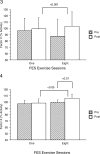Lower-extremity functional electrical stimulation decreases platelet aggregation and blood coagulation in persons with chronic spinal cord injury: a pilot study
- PMID: 20486534
- PMCID: PMC2869270
- DOI: 10.1080/10790268.2010.11689690
Lower-extremity functional electrical stimulation decreases platelet aggregation and blood coagulation in persons with chronic spinal cord injury: a pilot study
Abstract
Background: Individuals with spinal cord injury (SCI) develop premature cardiovascular disease. Regular exercise reduces the incidence and symptoms of cardiovascular disease in able-bodied individuals; these salutary effects of exercise have not been documented in persons with SCI.
Objective: To evaluate the effects of functional electrical stimulation leg cycle ergometry (FES-LCE) exercise training on platelet aggregation and blood coagulation in persons with SCI.
Participants: Subjects (n=14) with stable chronic (>1 year) paraplegia (T1-T10) or tetraplegia (C4-C8).
Methods: Blood samples were collected before and after the first and eighth sessions (2 sessions per week for 4 weeks) of FES exercise.
Results: Platelet aggregation was inhibited by 20% after the first session and by 40% (P < 0.001) after the eighth session. Thrombin activity was unchanged after the first session (10.7 +/- 0.85 s to 10.43 +/- 0.56 s) and decreased after the eighth session (12.5 +/- 1.98 s to 11.1 +/- 1.7 s; P < 0.0003). Antithrombin III activity increased after the first (103.8% +/- 8.9% to 110% +/- 6.9%; P < 0.0008) and eighth sessions (107.8% +/- 12.1% to 120.4% +/- 13.1%; P < 0.0001). Cyclic adenosine monophosphate increased after the first (9.9% + 2.5% to 15.8% +/- 3%; P < 0.001) and eighth sessions (17.8% +/- 4.2% to 36.5% +/- 7.6%; P < 0.0001). After the eighth session, factors V and X increased significantly (88% +/- 27% to 103% +/- 23%, P < 0.0001; 100% +/- 40% to 105% +/- 7%, P < 0.01, respectively); factors VII and VIII and fibrinogen did not change significantly. A significant reduction in platelet activation/aggregation was demonstrated in response to FES-LCE. The decrease in thrombin level was caused by the simultaneous increase in antithrombin activity.
Conclusion: These findings provide new insight into the potential protective effects of FES-LCE against the risk of cardiovascular disease.
Figures




Similar articles
-
Physiologic effects of electrical stimulation leg cycle exercise training in spinal cord injured persons.Arch Phys Med Rehabil. 1992 May;73(5):470-6. Arch Phys Med Rehabil. 1992. PMID: 1580776
-
Physiologic responses during functional electrical stimulation leg cycling and hybrid exercise in spinal cord injured subjects.Arch Phys Med Rehabil. 1997 Jul;78(7):712-8. doi: 10.1016/s0003-9993(97)90078-2. Arch Phys Med Rehabil. 1997. PMID: 9228873 Clinical Trial.
-
The effects of functional electrical stimulation leg cycle ergometry training on arterial compliance in individuals with spinal cord injury.Spinal Cord. 2008 Nov;46(11):722-6. doi: 10.1038/sc.2008.34. Epub 2008 Apr 15. Spinal Cord. 2008. PMID: 18414425 Free PMC article. Clinical Trial.
-
Development of Functional Electrical Stimulation Rowing: The Rowstim Series.Artif Organs. 2017 Nov;41(11):E203-E212. doi: 10.1111/aor.13053. Artif Organs. 2017. PMID: 29148129 Review.
-
Benefits and interval training in individuals with spinal cord injury: A thematic review.J Spinal Cord Med. 2022 May;45(3):327-338. doi: 10.1080/10790268.2021.2002020. Epub 2021 Dec 2. J Spinal Cord Med. 2022. PMID: 34855568 Free PMC article. Review.
Cited by
-
Functional electrical stimulation cycling exercise after spinal cord injury: a systematic review of health and fitness-related outcomes.J Neuroeng Rehabil. 2021 Jun 12;18(1):99. doi: 10.1186/s12984-021-00882-8. J Neuroeng Rehabil. 2021. PMID: 34118958 Free PMC article.
-
Electrical muscle stimulation in thomboprophylaxis: review and a derived hypothesis about thrombogenesis-the 4th factor.Springerplus. 2016 Jun 24;5(1):884. doi: 10.1186/s40064-016-2521-x. eCollection 2016. Springerplus. 2016. PMID: 27386332 Free PMC article. Review.
-
Does aerobic exercise benefit persons with tetraplegia from spinal cord injury? A systematic review.J Spinal Cord Med. 2021 Sep;44(5):690-703. doi: 10.1080/10790268.2020.1722935. Epub 2020 Feb 11. J Spinal Cord Med. 2021. PMID: 32043944 Free PMC article.
-
Effects of releasing ankle joint during electrically evoked cycling in persons with motor complete spinal cord injury.Sci Rep. 2024 Mar 18;14(1):6451. doi: 10.1038/s41598-024-56955-w. Sci Rep. 2024. PMID: 38499594 Free PMC article.
-
Neuromuscular electrical stimulation enhances the ability of serum extracellular vesicles to regenerate aged skeletal muscle after injury.Exp Gerontol. 2023 Jun 15;177:112179. doi: 10.1016/j.exger.2023.112179. Epub 2023 May 1. Exp Gerontol. 2023. PMID: 37087025 Free PMC article. Review.
References
-
- Laplante MP. Data on Disability from the National Interview Survey, 1983–85. Washington, DC: US Dept. of Education, National Institute on Disability and Rehabilitation Research; 1988.
-
- Bauman WA, Adkins RH, Spungen AM, et al. Is immobilization associated with an abnormal lipoprotein profile? Observations from a diverse cohort. Spinal Cord. 1999;37(7):485–493. - PubMed
-
- Bauman WA, Kahn NN, Grimm DR, Spungen AM. Risk factors for atherogenesis and cardiovascular autonomic function in persons with spinal cord injury. Spinal Cord. 1999;37(9):601–616. - PubMed
-
- DeVivo MJ, Krause JS, Lammertse DP. Recent trends in mortality and cause of deaths in persons with spinal cord injury. Arch Phys Med Rehabil. 1999;80(11):1411–1419. - PubMed
-
- Dearwater SR, Laporte RE, Robertson RJ, Brenes G, Adams LL, Becker D. Activity in the spinal cord injury patients: an epidemiological analysis of metabolic parameters. Med Sci Sports Exerc. 1986;18(5):541–544. - PubMed
MeSH terms
Substances
LinkOut - more resources
Full Text Sources
Medical
Research Materials
Miscellaneous
